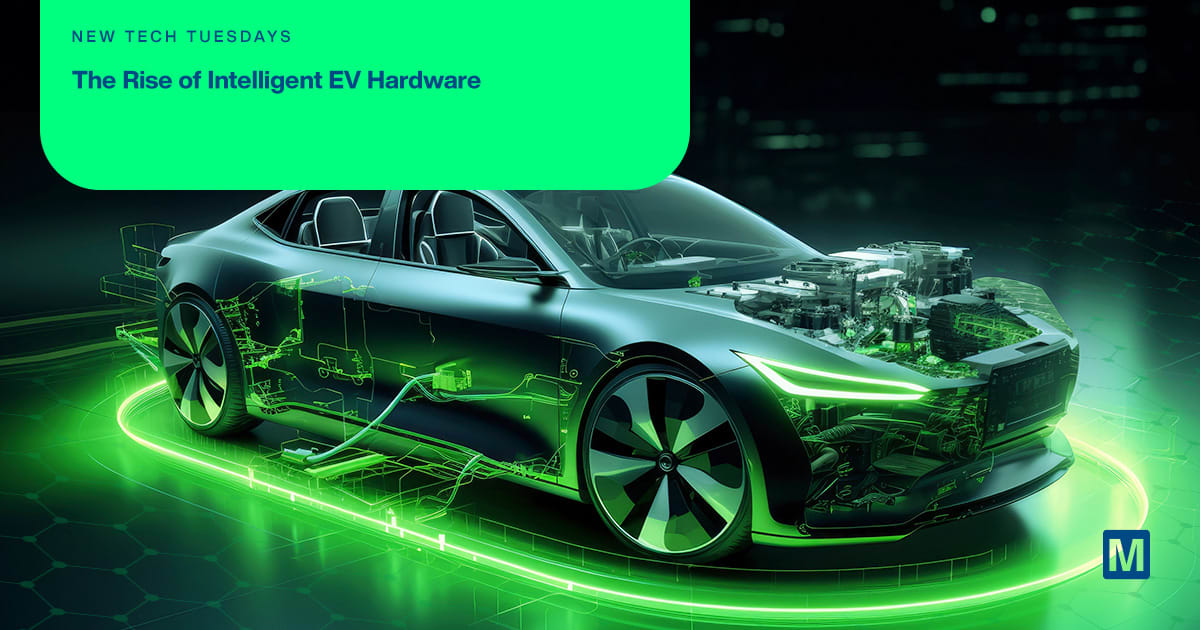New Tech Tuesdays: The Rise of Intelligent EV Hardware

New Tech Tuesdays
Join Mouser's Technical Content team for a weekly look at all things interesting, new, and noteworthy for design engineers.
Published November 25, 2025
Today’s electric vehicles (EVs) are becoming more like moving data centers. To support features like smart braking, adaptive cruise control, predictive maintenance, and driver monitoring, EVs and hybrid EVs (HEVs) depend on a growing stack of software to operate efficiently and safely.[1] Instead of having separate control units for functions like braking, steering, and infotainment, modern EVs are moving toward centralized platforms that can manage all of these operations with software (Figure 1). This vehicle architecture enables over-the-air (OTA) updates, flexible feature deployment, and faster iterations for original equipment manufacturers (OEMs).

Figure 1: Electric vehicle systems are becoming increasingly centralized, combining powertrain, artificial intelligence, safety, and diagnostics onto fewer, smarter hardware platforms. (Source: Rere_Art151/stock.adobe.com; generated with AI)
This shift comes with considerable computing demands, though. Vehicles must have ultra-reliable real-time processing for safety-critical tasks, local machine learning (ML) to adapt in real time, and hardware virtualization to consolidate functions without interference. Engineers need more than power to keep up. They need platforms that can provide efficient and adaptive workload management from the start.
In this week’s New Tech Tuesdays, we see how engineers are meeting these demands by turning to three critical technologies: real-time processing, ML acceleration, and hardware virtualization.
Real-Time Processing Is Non-Negotiable
Even a minor delay of a few milliseconds in adjusting torque can throw off how the vehicle feels to the driver. That kind of lag can create jerky acceleration (or even unresponsiveness), especially during quick changes in speed or terrain. This delicate reactive nature of EVs is why motor control, battery management, and power conversion systems depend on precise timing.
Modern automotive microcontrollers (MCUs) must handle both high-speed processing and guaranteed response times, even while balancing multiple tasks. In electric drives, that could mean calculating vector modulation while simultaneously monitoring fault signals and communicating over a controller area network (CAN) or local interconnect network (LIN).
ML Acceleration Delivers Smarter Decisions at the Edge
Today’s vehicles don’t wait for the cloud to think. ML models that run locally in EVs assist with tasks like checking battery health, detecting unusual motor activity, and adjusting braking patterns in real time. Because the data doesn’t have to be sent to the cloud, the system can react faster to tweak performance or flag issues as they occur. This can help extend battery life, improve range estimates, and make the driving experience more responsive.
ML technology unlocks unique features in modern vehicles, but running those models can take enormous computing power. To keep things fast and efficient, automotive processors now include built-in artificial intelligence (AI) accelerators. This gives them the ability to handle inference locally, so the main central processing unit (CPU) doesn’t get bogged down, and the system draws less power overall. ML acceleration also makes it possible for vehicles to support smart features like predictive maintenance or adaptive drive settings without relying on cloud connectivity.
Hardware Virtualization Isolates EV Applications
As cars pack more features into fewer chips, those chips need to run different systems simultaneously without interfering with each other. Hardware virtualization lets engineers run several independent applications, such as motor control, diagnostics, and infotainment, on the same processor without risking cross-contamination or crashes.
In a typical system, critical functions, such as torque control, may run alongside non-critical ones, like the infotainment user interface (UI). Hardware virtualization allows both to share the same processor while remaining isolated, so a software update to the display system won’t affect real-time control loops or safety logic.[2]
The Newest Products for Your Newest Designs®
The NXP Semiconductors S32E288-975EVB evaluation board is designed to help engineers prototype EV and HEV control systems that demand high performance, safety, and flexibility. Built around the S32E2 real-time processor, the board supports complex workloads with a 32-bit Arm® Cortex®-R52 core, integrated motor control peripherals, and support for ISO 26262 ASIL D safety levels.
The board supports hardware-assisted virtualization and ML workloads, making it well-suited for software-defined vehicles. Developers can test time-sensitive control algorithms, edge inference models, and consolidated architectures—all on a single platform.
With its suite of I/O ports, expansion headers, and debugging support, the S32E288-975EVB helps accelerate the development of high-reliability automotive systems.
Tuesday’s Takeaway
EVs and HEVs are only getting smarter, and the brains behind them must keep pace. As architectures become increasingly software-driven, the control hardware needs to support real-time processing, safety isolation, and embedded AI on a shared compute platform. Choosing a development board with these capabilities built in can reduce system complexity and speed up validation. Whether you’re prototyping a traction inverter, a zonal controller, or a diagnostics system, the NXP S32E288-975EVB offers the processing performance and hardware isolation needed for production-grade development.
Sources
[1]https://www.mobilityengineeringtech.com/component/content/article/46224-sae-ma-06960